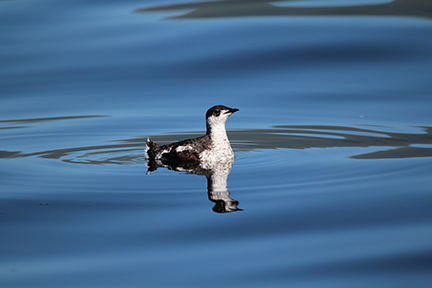Marbled Murrelet
The Marbled Murrelet is a species of conservation concern in Canada and the U.S. due to its wide distribution and need for large areas of old forest for nesting. The Province is working to meet federal recovery strategy objectives through a provincial implementation plan that includes habitat protection, population monitoring and research actions.
On this page:
- What is a Marbled Murrelet?
- Conservation status and protection measures
- Implementation and management actions
What is a Marbled Murrelet?
The Marbled Murrelet (Brachyramphus marmoratus) is a small north Pacific seabird that nests in old growth forests. Murrelets lay a single egg in a small depression in the moss on large, wide branches of old growth trees. They can travel over a hundred kilometres a day between their inland nest sites and marine foraging areas, where they hunt for small fish to feed their chicks. Murrelets are unusual among seabirds in their solitary and secretive nesting habits. They avoid predators by flying silently at high speeds (greater than 80 km/h) during dark twilight to visit their secluded forest nests. In contrast, most seabirds nest in large, dense, and noisy colonies in areas inaccessible to predators, such as cliffs and offshore islands.
Conservation status and protection measures
The Marbled Murrelet has been listed as threatened under the federal Species at Risk Act since 2003, based on Committee on the Status of Endangered Wildlife in Canada (COSEWIC) assessments in 1990, 2000 and 2012. This species is categorized as blue (special concern) in British Columbia and is identified as a species at risk under the provincial Forest and Range Practices Act.
Like other birds, the Marbled Murrelet, its occupied nests, and eggs are legally protected from harm under B.C.'s Wildlife Act. Due to its federal status as a migratory bird and as a threatened species, the Marbled Murrelet and its nests are also protected under the federal Migratory Birds Convention Act and Species at Risk Act. Marbled Murrelet habitat can be protected under provincial legislation, particularly the Forest and Range Practices Act, Oil and Gas Activities Act, and Land Act.
Implementation and management actions
The main threat to Marbled Murrelets' terrestrial nesting habitat is the loss and fragmentation of old growth forests.
The provincial implementation plan for the recovery of Marbled Murrelet outlines priorities, actions and timelines including measures to maintain sufficient nesting habitat on provincial Crown land to support viable populations of Marbled Murrelet across their range in B.C.
More than 48,000 hectares of terrestrial nesting habitat has been designated in wildlife habitat areas (WHAs). Habitat has also been protected in parks and other land use designations. A key objective in the implementation plan is to protect additional habitat on Vancouver Island and the southern mainland coast. An order under the Land Use Objectives Regulation of the Land Act establishes the additional amount of suitable habitat (approximately 60,000 hectares) to be protected on provincial Crown land. A revised notice under section 7 of the Forest Planning and Practices Regulation and section 9 of the Woodlot Licence Planning and Practices Regulation of the Forest and Range Practices Act guides the future establishment of spatially defined reserves (wildlife habitat areas and old growth management areas).
In the northern conservation regions (central and northern mainland coast, Haida Gwaii), the Province is committed to monitoring the availability of suitable nesting habitat over time, including the amount protected, to ensure suitable habitat availability exceeds the minimum habitat threshold for Crown lands.
- Implementation Plan for the Recovery of Marbled Murrelet (Brachyramphus marmoratus) in British Columbia – 2018 (PDF, 0.9MB)
- Order for the Recovery of Marbled Murrelet (Brachyramphus marmoratus) – effective Dec 2, 2021 (PDF, 20.4MB)
- Notice - Indicators of the Amount, Distribution and Attributes of Wildlife Habitat Required for the Survival of Marbled Murrelet (Brachyramphus marmoratus) – effective Dec 2, 2021 (PDF, 1.6MB)
- Notice Backgrounder – Nov 2021 (PDF, 1.0MB)
- Marbled Murrelet Wildlife Habitat Areas (WHAs) established under the Government Actions Regulation of the Forest and Range Practices Act
- Marbled Murrelet Wildlife Habitat Areas (WHAs) established under the Environmental Protection and Management Regulation of the Oil and Gas Activities Act
- Land Use Objectives for Haida Gwaii, including Objectives for Marbled Murrelet Habitat
- Land Use Objectives for Clayoquot Sound, including Marbled Murrelet Reserves
Spatial data (geodatabase and shapefile formats) of Marbled Murrelet suitable habitat within Crown Land is available for download from the B.C. Government FTP site.

